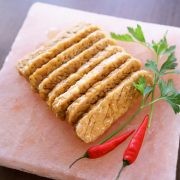How to use Himalayan Salt Block
Have you cooked on a salt block before? It’s the coolest thing ever. Mine is small square Himalayan Salt Block from The Salt Box who, aside from stocking a range of salt blocks, also sells an incredible variety of salt.
Cooking with salt block not only make it looks impressive, but also makes the food deliciously salty and flavoursome.

What is a salt block?
Salt block is essentially a slab of pure salt. In my case, I use the Himalayan salt block which has the prettiest pink hue. Himalayan salt thought to have first formed around 250 million years ago, when the sun dried up a prehistoric ocean, leaving a dense salt deposit, colored by a common pink microorganism that had lived in it.
Now let that sink in a little bit. 250 million years! So next time you use Himalayan salt, know that you are in fact eating something that comes from the ancient time.
Cooking with salt block can be intimidating at first but once you give it a go, it is actually really simple.
Here are some of my tips if you’re new to cooking with salt block.
1. Acclimatise your salt block
This is important to ensure that they won’t crack under high heat, especially if they are new. Just bring them up to temperature slowly, in stages. So heat the block using a low heat (under 100 degrees C) for about 15 minutes, then increase it to a medium heat (about 150 degrees C) for another 15 minutes, and then on high (around 200 degrees C) until it reaches temperature. This applies to gas stove top and grill. Note: you’re using electric, use a diffusing ring (or anything metal like a tart pan with a pop out bottom or a pastry ring) to create a small air gap between the heating element and the salt block and then follow the same process.
It is quite a slow process so give yourself enough time. Each time you want to cook with the salt block it will take 45 minutes in the oven to reach the ideal cooking temperature. I do this whilst I do my food preparation so I don’t have to wait for too long for the block to heat up.
The salt block or plate will change its appearance to a more opaque colour when heated and it may also crackle a bit. Don’t worry too much about it as the salt block will return to its original look once it cools down.

2. Keep the salt block hot
Because otherwise, your food will absorb too much salt. You need to salt block to be hot enough to evaporate the moisture in the food. To test this, I would just add a drop of water onto the salt block. If it sizzles violently and evaporates quickly, it’s hot enough. Don’t worry, you get the hang of this.
3. Designate a ‘top’ and ‘bottom’
In other words, use the same side of the salt block for searing food. This is to maintain the integrity of the salt block as it can start to break down faster if both sides are used as the cooking surface.
4. Treat it with a bit of TLC
First of all, do not wash your salt block under running water. Do not use soap, ever (unless you want soap flavoured salt)! If hot, allow your block to cool completely first and use a scrub or a soft brush to remove any stuck matter and wipe with damp cloth. The less water the better. I normally scrape any sticky bits with a knife and then just wipe them clean. It may seem a bit unsanitary but keep in mind is that salt block has powerful antimicrobial properties so you don’t need to worry about things growing on them. You can keep your salt block in a sealed plastic when it’s not in use.
I use my salt block mostly to grill tempe. The salt block imparts a lovely sea flavour and it’s so simple to make. Here’s a quick recipe/direction on how I do it.

Grilled Tempe on Himalayan Salt Block
Ingredients
- 250g organic tempe
- Himalayan salt block
Method
- Heat up the salt block to high (200 degrees C)
- Slice tempe into 1 cm slices.
- Add a drizzle of olive oil and place tempe slices on the hot salt block
- Cook for 1-2 minutes on each side and then turn and cook the other side.
- You can use the remaining heat to sear other veggies like asparagus or mushroom
Have you used salt block before? If not, would you try it? And if yes, what’s your favourite way to use salt block.

